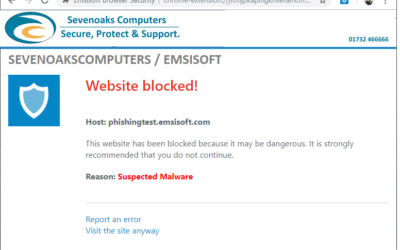Blog 1: What is EDR and Why Your Business Needs It
In the ever-evolving landscape of cybersecurity, staying ahead of threats is no longer optional—it’s a necessity. Businesses are prime targets for cybercriminals, and traditional security measures like antivirus software are no longer enough to fend off sophisticated attacks. Enter Endpoint Detection and Response (EDR), a next-generation solution that’s transforming how organizations protect their digital assets. But what exactly is EDR, and why should your business invest in it? Let’s break it down.
The Evolution from Antivirus to EDR
The Limitations of Traditional Antivirus
Antivirus software has been a cornerstone of digital security for decades. It works by scanning files, applications, and data against a database of known malware signatures. While effective for blocking familiar threats, traditional antivirus solutions struggle with detecting new, sophisticated, or evasive attacks, such as zero-day exploits and fileless malware.
Here’s why traditional antivirus solutions fall short:
- Signature Dependence: Antivirus relies on predefined signatures, making it ineffective against novel threats.
- Limited Scope: It focuses on prevention and does little to address post-infection scenarios.
- Static Protection: It’s designed for known threats, leaving gaps for more advanced attack methods.
What is EDR?
Endpoint Detection and Response (EDR) represents a significant leap forward in endpoint security. Unlike traditional antivirus, EDR combines real-time monitoring, behavioral analysis, and automated response capabilities to detect and mitigate threats proactively. It’s not just about stopping attacks but understanding, containing, and recovering from them.
EDR provides a more dynamic and comprehensive approach to cybersecurity by:
- Detecting Behavioral Anomalies: Identifying unusual activity that may indicate an attack.
- Providing Contextual Insights: Offering detailed information about the nature and scope of a threat.
- Facilitating Incident Response: Enabling swift containment and mitigation of detected threats.
Real-Time Monitoring, Threat Detection, and Response
Real-Time Monitoring
One of EDR’s core functionalities is real-time monitoring. This feature continuously observes endpoint activities, looking for irregularities that might signify malicious intent. Unlike traditional antivirus, which conducts periodic scans, EDR operates 24/7, ensuring no suspicious behavior goes unnoticed.
Key Benefits:
- Immediate detection of suspicious activities.
- Continuous surveillance reduces blind spots.
- Early warnings for potential breaches.
For example, if an employee inadvertently downloads a malicious attachment, EDR’s real-time monitoring can detect unusual behavior, such as unauthorized data access, before significant damage occurs.
Threat Detection
EDR systems utilize advanced threat detection mechanisms, including:
- Behavioral Analysis: Examining patterns of activity to identify anomalies.
- Machine Learning: Leveraging AI to recognize new and emerging threats.
- Threat Intelligence Integration: Correlating data with global threat databases for enhanced accuracy.
These features allow EDR to detect:
- Malware
- Ransomware
- Phishing attacks
- Insider threats
Unlike signature-based antivirus software, EDR is designed to adapt and evolve with the threat landscape.
Automated Response
Once a threat is detected, EDR doesn’t just alert the security team—it takes action. Automated response capabilities allow EDR to:
- Isolate Infected Endpoints: Contain the threat by disconnecting compromised systems.
- Neutralize Threats: Quarantine or remove malicious files.
- Trigger Security Protocols: Enforce predefined actions to limit the impact of an attack.
By automating these responses, EDR reduces the time it takes to react to an incident, which is crucial in minimizing potential damage.
Why Businesses Can’t Rely on Reactive Security Alone
The Changing Threat Landscape
Cybercriminals are becoming more sophisticated, employing advanced tactics to bypass traditional security measures. According to a 2023 cybersecurity report, over 70% of successful breaches exploited endpoints as their primary entry point. This statistic underscores the importance of a proactive security approach.
Proactive vs. Reactive Security
Reactive security, like traditional antivirus, waits for an attack to occur before taking action. While this may have been sufficient in the past, today’s threats demand a proactive approach.
Proactive security involves:
- Anticipating Threats: Identifying vulnerabilities before they’re exploited.
- Continuous Monitoring: Keeping a vigilant eye on potential attack vectors.
- Quick Response: Taking immediate action to mitigate threats.
The Cost of Downtime
Relying on reactive security can lead to significant downtime and financial loss. Consider this:
- Data Breaches: The average cost of a data breach in 2023 was $4.45 million.
- Operational Disruption: A single attack can halt business operations for days.
- Reputation Damage: Losing customer trust can have long-term repercussions.
By adopting EDR, businesses can prevent these costly scenarios, ensuring business continuity and safeguarding their reputation.
How EDR Differs from Traditional Antivirus
| Feature | Traditional Antivirus | Endpoint Detection and Response (EDR) |
| Focus | Prevention of known threats | Detection, investigation, and response |
| Detection Mechanism | Signature-based | Behavioral and AI-driven |
| Scope | Limited to malware scanning | Comprehensive endpoint activity |
| Incident Response | Manual | Automated and actionable |
| Adaptability | Static | Dynamic and evolving |
The table above highlights how EDR outperforms traditional antivirus solutions, making it a must-have for modern businesses.
Why Your Business Needs EDR
Enhanced Visibility
EDR provides unparalleled visibility into endpoint activity, enabling businesses to:
- Monitor all devices and applications in real time.
- Identify potential vulnerabilities.
- Understand the full scope of an attack.
Improved Incident Response
With EDR, security teams can:
- Act faster with automated responses.
- Access detailed forensics for better decision-making.
- Reduce the mean time to detect (MTTD) and mean time to respond (MTTR).
Compliance and Reporting
Regulatory compliance is a growing concern for businesses across industries. EDR helps organizations meet compliance standards by:
- Maintaining detailed activity logs.
- Providing robust reporting tools.
- Demonstrating proactive security measures during audits.
Scalability for Growing Businesses
As your business grows, so do your security needs. EDR solutions are scalable, ensuring your endpoints remain protected no matter how large your operation becomes.
Implementing EDR in Your Organization
Step 1: Assess Your Needs
Before adopting EDR, evaluate your current security posture. Identify gaps and vulnerabilities in your existing systems.
Step 2: Choose the Right Solution
Not all EDR solutions are created equal. Look for a provider that offers:
- Seamless integration with your existing infrastructure.
- User-friendly interfaces for easy management.
- 24/7 support and regular updates.
Step 3: Train Your Team
Invest in training to ensure your IT team and employees understand how to use the EDR system effectively.
Step 4: Continuous Evaluation
Regularly review your EDR system’s performance. Stay informed about new features and updates to maximize its capabilities.
Conclusion
In a world where cyber threats are growing in both frequency and complexity, Endpoint Detection and Response (EDR) is no longer a luxury—it’s a necessity. By providing real-time monitoring, advanced threat detection, and automated response capabilities, EDR empowers businesses to stay one step ahead of attackers. Unlike traditional antivirus, EDR offers a proactive approach to security, ensuring your endpoints are protected from both known and emerging threats.
Don’t wait for a breach to expose the weaknesses in your security system. Invest in EDR today and give your business the protection it deserves.



